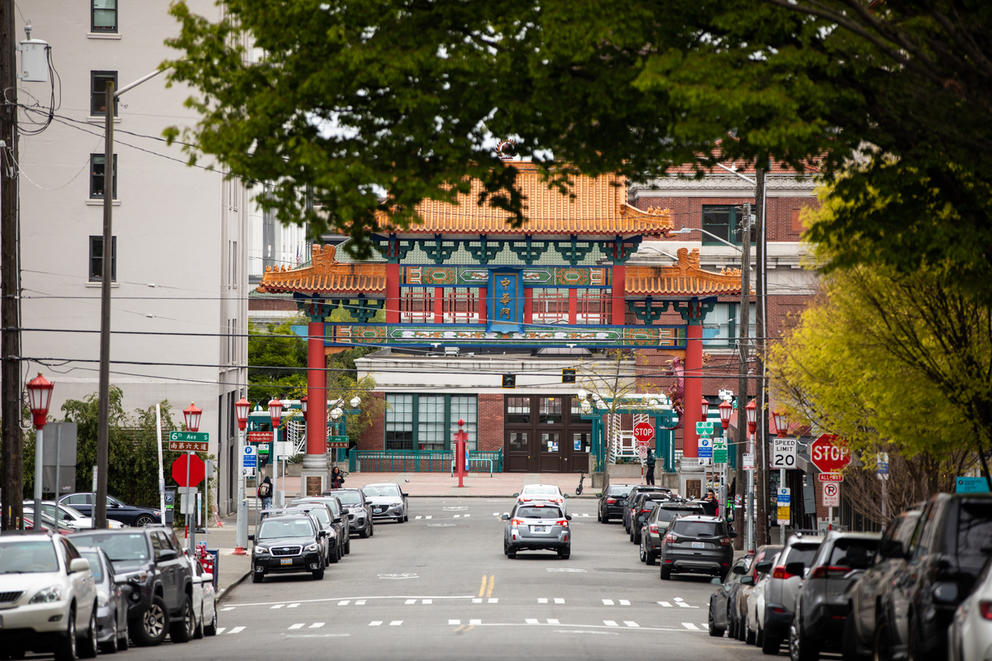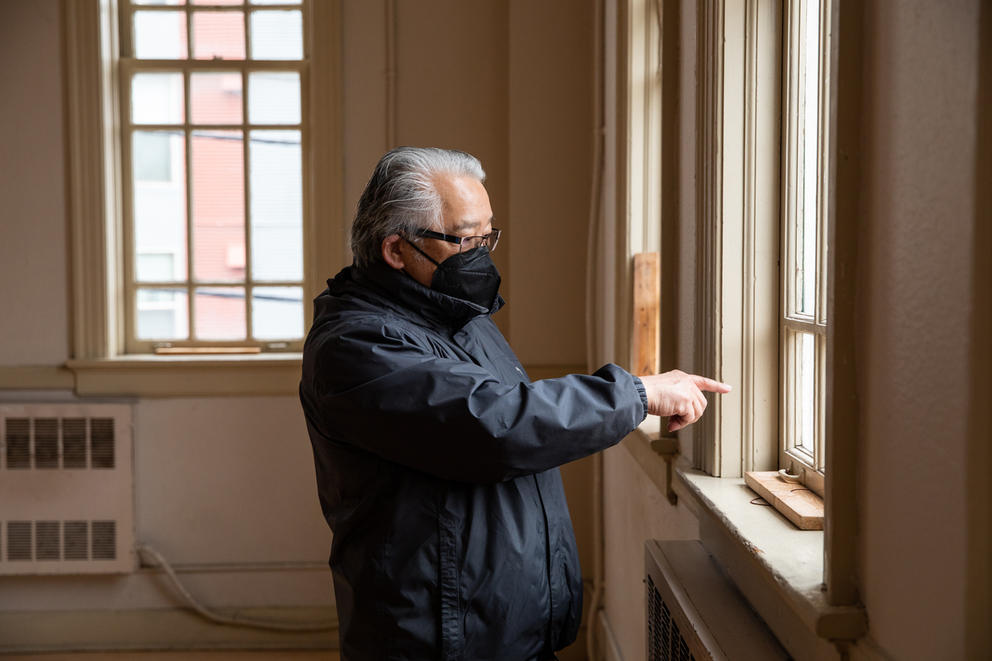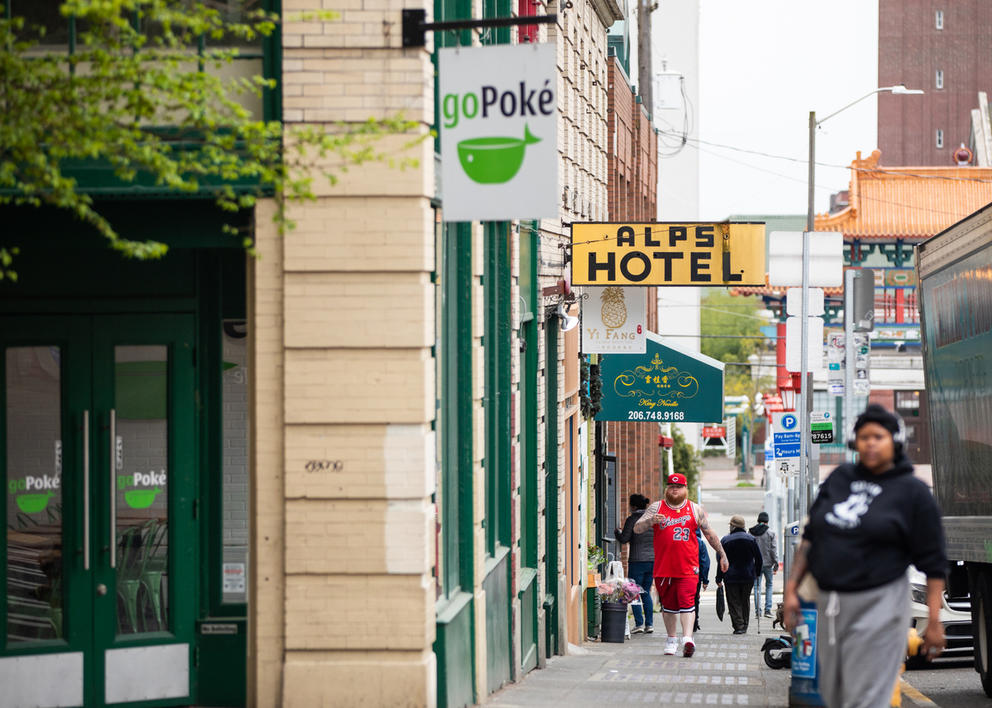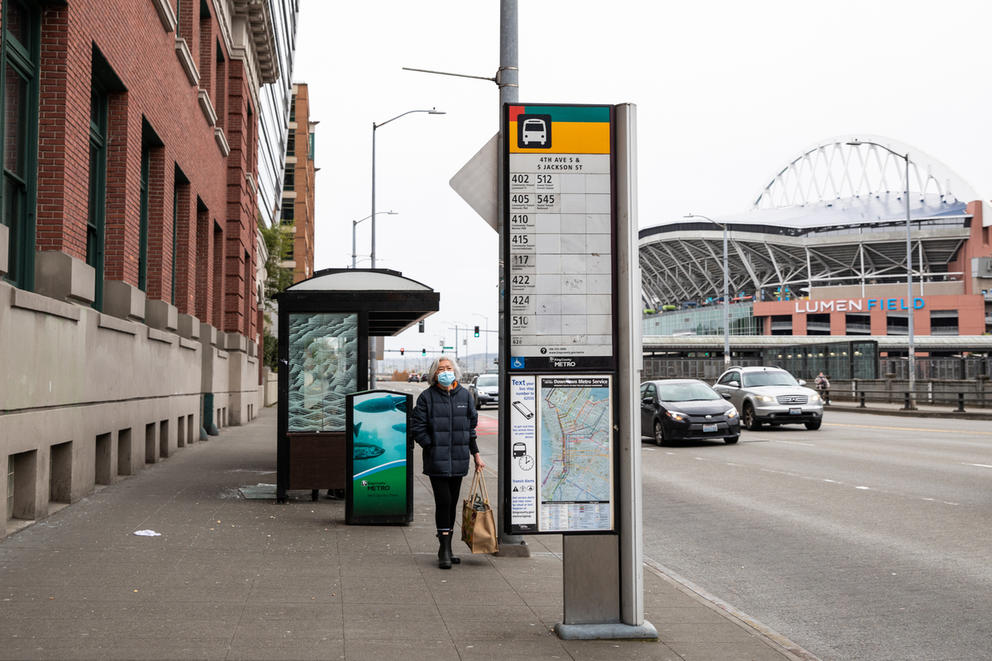But community leaders in the Chinatown-International District fear the neighborhood as they know it may not survive the next megaproject upheaval.
Sound Transit is currently planning the third phase of regional Link light rail expansion, a $54 billion, decades-long project. The expansion includes construction of a new line from West Seattle to Ballard that will require a second train tunnel underneath the city, including part of the Chinatown-International District.
The agency is considering two locations for where to route the tunnel under the district: Fifth Avenue or Fourth Avenue. If built under Fifth Avenue, the nearly decade-long tunnel construction will take place in the heart of the neighborhood — something community members say will devastate the Chinatown-International District’s Asian businesses and residents. The Fourth Avenue alignment is not without impacts, but construction would largely take place on the edge of the district, on the west side of Union Station.
“This is our third and final Chinatown,” said Betty Lau, one of the lead organizers with Transit Equity for All. “The original Chinatown was forced from the waterfront onto Second and Washington. Then Chinatown was forced to move to the current location. If we're forced out again, where are we going to go?”
Transit Equity for All is a large coalition of neighborhood businesses, community institutions, residents and other supporters lobbying Sound Transit to build under Fourth Avenue. It includes representatives from United Chinese Americans, Chinese American Civic Organization, NW Association of Chinese Language Schools, Friends of Chinatown, King Apartments, Panama Hotel & Teahouse, Washington Trust for Historic Preservation and many others.
The coalition is led by Lau and Brien Chow, two longtime community leaders and board members for the historic Chong Wa Benevolent Association, a Chinese community and cultural center on Seventh Avenue and Weller Street. Lau is a retired public school teacher and has spent decades doing neighborhood advocacy. Chow’s mother was restaurateur-turned-politician Ruby Chow, the first Asian American elected to the King County Council. His sister was former Seattle City Councilmember Cheryl Chow.
The choice between Fifth and Fourth
Sound Transit’s proposed tunnel options and their impacts are spelled out in a document called the Draft Environmental Impact Statement. In the Chinatown-International District there are proposals for either a deep or shallow tunnel under both Fifth and Fourth avenues. Construction is expected to last upwards of eight to 10 years.
Chinatown-International District's core business area sits between Jackson and Weller streets to the north and south, and Fifth and Eighth avenues to the west and east. Those eight square blocks contain Oasis Tea Zone, Shanghai Garden, Kau Kau, the Uwajimaya grocery store and many more of the neighborhood’s anchor restaurants and shops as well as residential buildings.
Construction of the Fifth Avenue tunnel would be staged at two sites between Fifth and Sixth avenues near Weller Street, both of which would be partly closed during several years of construction. In the early years of building that tunnel, a fleet of dump trucks would be driving in and out of the neighborhood all day long, removing tunnel dirt.
To make space for construction, the future station site and other infrastructure, such as the ventilation, Sound Transit will have to demolish several existing buildings. The draft environmental impact statement estimates 19 to 27 businesses with 170 to 230 employees would be displaced if the agency moves forward with the Fifth Avenue plan, though some of them are expected to be temporary displacements during construction.
Chow and Lau fear even more businesses than that will go under, with nearly a decade of construction leaving the neighborhood with fewer visitors and patrons.
Cassie Chinn, Wing Luke Museum’s interim executive director, said that during the much smaller Jackson Street streetcar construction, the museum saw a 30% drop in revenue from visitors.
“In Washington D.C.’s Chinatown, there’s hardly anything left,” said Lau. “That's what's going to happen to Seattle.”
D.C.’s Chinatown went from a majority Asian population to less than 20% Asian, in part because of impacts from the construction of the neighborhood Metro station and ensuing gentrification.
The leaders of Transit Equity for All also worry about the impacts not spelled out in Sound Transit’s analysis, such as the neighborhood’s elders losing access to Hing Hay Park, which they use as a gathering space and place for daily exercise. The park would be adjacent to the construction zone.
Chow is particularly worried about the tunnel ventilation infrastructure that will be installed in the neighborhood and its potential impact on air quality. But Sound Transit said in a statement that “light rail vehicles are electrically powered (from clean energy sources) and would not generate the sort of air quality concerns beyond what one might expect from conventional commercial building ventilation systems.”
Building a tunnel beneath Fourth Avenue is not without impacts, either. The street is an entryway to downtown for several dozen city and regional bus lines and a busy car route. Construction would shut down part of Fourth Avenue for upwards of six years of the project, likely rerouting some bus and car traffic into the Chinatown-International District.
Construction would also force the Icon Apartment building across the street from Union Station to close for four years, displacing the 120 residents who live there. The Bartell Drug Store in the building’s ground floor would also have to close during that time.
A Fourth Avenue tunnel would cost $500 million more than one running under Fifth Avenue, in part because it would likely include the cost of replacing the Fourth Avenue viaduct. The street is built on an elevated platform near Union Station. That aging infrastructure will need to be replaced in the not too-distant future, said Seattle City Councilmember Alex Pedersen, chair of the council transportation committee, so it might be more efficient to include that project as part of the light rail construction.
Transit Equity for All argues that the Fourth Avenue tunnel makes more sense because there are no businesses or restaurants along that street to displace. The street is mostly lined by the sides of Union Station and several office buildings and parking garages.
Political decisions
Ultimately, the decision of where to build the tunnel is up to the Sound Transit Board of Directors, which will weigh the impacts outlined by the environmental impact statement, along with costs, public input and other factors. That final decision on the project won’t be made until 2023. Construction will begin in 2026. Sound Transit has not yet stated whether it prefers Fourth Avenue or Fifth Avenue for the tunnel.
The Seattle City Council and Mayor Bruce Harrell, in a joint resolution to be voted on in June, will also weigh in on where to put tunnels and stations in the city. The city is also represented by council President Debora Juarez and Harrell on Sound Transit’s board.
Councilmember Pedersen said he shares the communities’ concerns about the impacts of the Fifth Avenue tunnel and that the Fourth Avenue construction plan makes sense to him.
“This is a very ambitious megaproject and there are going to be massive generational benefits from expanding the light rail system,” said Pedersen. “At the same time, you can't put a price tag on avoiding additional devastation on a community that's experienced historic harms from transportation construction. … It's worth investing more to prevent displacement and harm to businesses and residents.”
District 2 Councilmember Tammy Morales, who represents the Chinatown-International District, said she wants to see a much deeper analysis from Sound Transit about the potential harms the two projects could have in the neighborhood in the short and long term.
“In 100 years, what is this going to look like?” Morales asked. “How is the next generation and the next one after that going to be impacted by the neighborhood change as a result of these investments? … We know there will be impacts. What are we doing to mitigate them and make sure the harm is as minimal as possible?”
As with the councilmembers, Mayor Harrell acknowledged the historical harms suffered by the Chinatown-International District and said Sound Transit needs to provide deeper analysis.
"Any decision on station options must come once we have more fully developed station alternatives that consider the full range of impact and include adequate mitigation to make them work for community, for the City and for our other partners," said a Mayoral spokesperson in an email. "The work to date in Sound Transit’s DEIS doesn’t fully do that, and so we want to see that take place so that we are informed when we choose an alternative for the Chinatown-International District."
The transit advocates at Seattle Subway see the Fourth Avenue tunnel as a win-win for the quality of service and minimizing impacts on the Chinatown-International District. Seattle Subway is lobbying the agency to study building an even shallower tunnel on Fourth Avenue than the one currently proposed. Doing so would reduce the amount of transfer time for riders at the existing International District/Chinatown Station which will serve as a hub for several of the region’s light rail lines.
A view of Fourth Avenue, where community leaders in the Chinatown- International District want Sound Transit to pursue the Link light rail expansion, seen on April 20, 2022. They argue that a Fourth Avenue tunnel would have less negative impact on the neighborhood. But it’s likely is the more expensive alternative. (Amanda Snyder/ Crosscut)
“The longer it takes to get to the platform, the worse this system is for riders, period,” said Seattle Subway Treasurer Ben Broesamle. “We think a lot of impacts on Fifth Avenue to the community are extensive and perhaps permanently harmful and that improving Fourth Avenue and creating an intermodal direct transfer is really awesome.”
The public comment period for the draft environmental impact statement is still open through the end of the day April 28. People can submit comments to the agency through this survey.
Echoes of past megaprojects
The neighborhood’s current predicament is familiar territory, something the Wing Luke Museum’s Chinn said is no coincidence.
“There were structures in place to disenfranchise Asian American communities,” she said. “Because of Asian exclusion laws, there wasn't a pathway to citizenship for Asian immigrants until the 1950s, which is going to impact voter participation and civic engagement. … Structural racism has resulted time and time again in public infrastructure projects having harmful impacts on Chinatowns generally and our own C-ID.”
Still, much like Transit Equity for All, community organizing efforts in the Chinatown-International District often fought back against projects and tried to minimize their harms.
The Jackson Street Community Council was formed by Black and Asian community and business leaders along the Jackson Street corridor in 1947. When I-5 threatened the neighborhood, the council did its best to reroute the freeway, as well as highlight the negative impact it would have on people and businesses, though ultimately the project went forward as planned.
When the original Metro bus tunnel was built in the 1980s, Asian businesses along Fourth Avenue were displaced during construction and never returned. It took a concerted community organizing effort to get the agency to install Asian art in the station to draw a connection to the neighborhood the tunnel and station had impacted.
Sue Taoka, a longtime community activist, former director of InterIm CDA, and mentee of the famed activist Bob Santos said Seattle’s Chinatown still exists today in large part because of organizing that happened in response to the Kingdome stadium construction.
When the Kingdome threatened to turn the neighborhood into a stadium parking lot, activists organized community members to fight back. They showed up en masse at meetings and ultimately enshrined zoning laws that prevented huge parking lots and car-oriented businesses from taking over the neighborhood.
“It got to the point where city council was scared of having all these little old Chinese ladies and men showing up angry about the impact these things were having,” Taoka said. “There was a sense that there was power and a bloc of people to show up if they needed to.”
Still, Taoka and Chinn want politicians and government agencies to do a better job of listening to what the community wants and not paying lip service to its needs.
“Why are we always the ones in the position of having to adapt and be resilient?” asked Chinn. “When can we be in the position of having agency over our own destiny and having the resources to determine our own future instead of having to react to these transformational infrastructure projects time and time again?”
Correction: An earlier version of this article misstated the length of road and apartment closures during Fourth Avenue tunnel construction and the boundaries of the Fifth Avenue tunnel construction impacts.






